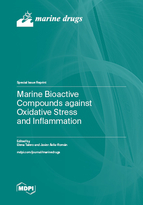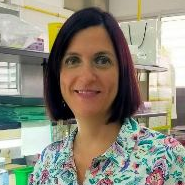Marine Bioactive Compounds against Oxidative Stress and Inflammation
A special issue of Marine Drugs (ISSN 1660-3397). This special issue belongs to the section "Marine Pharmacology".
Deadline for manuscript submissions: closed (30 September 2023) | Viewed by 27361
Special Issue Editors
Interests: pharmacology; inflammation; cancer; colon; skin; polyphenols; carotenoids; microalgae; probiotics
Special Issues, Collections and Topics in MDPI journals
Interests: marine microalgae; inflammation; oxylipins; inflammatory bowel disease; colon cancer; inflammatory skin diseases
Special Issues, Collections and Topics in MDPI journals
Special Issue Information
Dear Colleagues,
Acute inflammation is a defense mechanism of the body aimed to remove harmful stimuli, including pathogens, irradiation, toxic agents, or tissue damage. Nevertheless, uncontrolled acute inflammation can lead to chronic inflammation, which plays a key role in the pathogenesis of many diseases. Furthermore, oxidative stress is considered an imbalance between the excessive production of reactive oxygen species (ROS) and their neutralization by the antioxidant system, which plays a pathogenic role in chronic inflammatory diseases. ROS can activate many signaling pathways and transcription factors, including MAPK and NF-kB, which induce the expression of a variety of pro-inflammatory mediators.
In recent years, the need to find new bioactive molecules has raised the interest of the scientific community in the marine environment, which represents an important source to obtain bioactive compounds from bacteria, cyanobacteria, fungi, microalgae, algae, or small invertebrates, such as sponges and mollusks. This Special Issue in Marine Drugs will cover the use of marine agents with antioxidant and anti-inflammatory activities. We invite researchers to submit their papers (reviews or original articles) reporting evidence of the role of marine products in cellular and animal models, as well as the latest advances in clinical trials. In particular, works that evaluate the molecular mechanisms of these compounds are especially encouraged.
Prof. Dr. Elena Talero
Dr. Javier Ávila-Román
Guest Editors
Manuscript Submission Information
Manuscripts should be submitted online at www.mdpi.com by registering and logging in to this website. Once you are registered, click here to go to the submission form. Manuscripts can be submitted until the deadline. All submissions that pass pre-check are peer-reviewed. Accepted papers will be published continuously in the journal (as soon as accepted) and will be listed together on the special issue website. Research articles, review articles as well as short communications are invited. For planned papers, a title and short abstract (about 100 words) can be sent to the Editorial Office for announcement on this website.
Submitted manuscripts should not have been published previously, nor be under consideration for publication elsewhere (except conference proceedings papers). All manuscripts are thoroughly refereed through a single-blind peer-review process. A guide for authors and other relevant information for submission of manuscripts is available on the Instructions for Authors page. Marine Drugs is an international peer-reviewed open access monthly journal published by MDPI.
Please visit the Instructions for Authors page before submitting a manuscript. The Article Processing Charge (APC) for publication in this open access journal is 2900 CHF (Swiss Francs). Submitted papers should be well formatted and use good English. Authors may use MDPI's English editing service prior to publication or during author revisions.
Keywords
- marine compounds
- antioxidant molecules
- anti-inflammatory molecules
- inflammation
- oxidative stress
- immune response
- proinflammatory mediators








